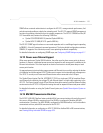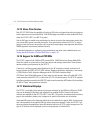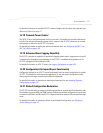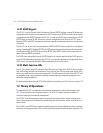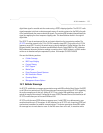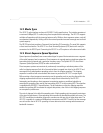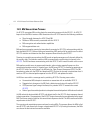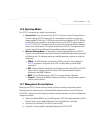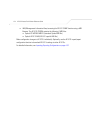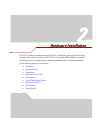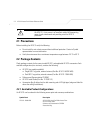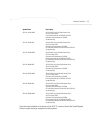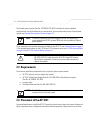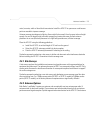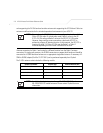
AP-5131 Introduction
1-23
1.3.6 Operating Modes
The AP-5131 can operate in a couple of configurations.
• Access Point - As an Access Point, the AP-5131 functions as a layer 2 bridge (similar to
Symbol’s existing AP-4131 access point). The wired uplink can operate as a trunk and
support multiple VLANs. Up to 16 WLANs can be defined and mapped to AP-5131 WLANs.
Each WLAN can be configured to be broadcast by one or both AP-5131 radios (unlike the
AP-4131). The AP-5131 can operate in both an Access Point mode and Wireless Gateway/
Router mode simultaneously. The network architecture and AP-5131 configuration define
how the Access Point and Wireless Gateway/Router mode are negotiated.
• Wireless Gateway/Router - If operating as a Wireless Gateway/Router, the AP-5131
functions as a router between two layer 2 networks: the WAN uplink (the ethernet port) and
the Wireless side. The following options are available providing a solution for single-cell
deployment:
• PPPoE - The WAN interface can terminate a PPPoE connection, thus enabling the
AP-5131 to operate in conjunction with a DSL or Cable modem to provide WAN
connectivity.
• NAT - (Network Address Translation) on the Wireless interface. Using NAT, the AP-5131
router is able to manage a private IP scheme. NAT allows translation of private
addresses to the WAN IP address.
• DHCP - On the Wireless side, the AP-5131 can assign private IP addresses.
• Firewall - In between the WAN and Wireless interfaces, a Firewall protects against a
number of known attacks.
1.3.7 Management Access Options
Managing the AP-5131 includes viewing network statistics and setting configuration options.
Statistics track the network activity of associated MUs and data transfers on the AP interfaces.
The AP-5131 requires one of the following connection methods to perform a custom installation and
manage the network:
• Secure Java-Based WEB UI - (use Sun Microsystems’ JRE 1.5 or higher available from Sun’s
Web site and be sure to disable Microsoft’s Java Virtual Machine if installed)
• Command Line Interface (CLI) via Serial, Telnet and SSH
• Config file - Human-readable; Importable/Exportable via FTP and TFTP



